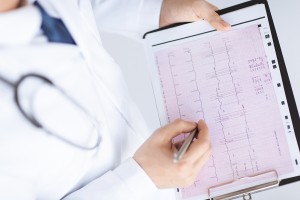 An Exercise Stress Test is to assess how your heart responds to physical exertion. An ECG is recorded at rest, and then whilst walking on a treadmill. Throughout the test a Technician and a Medical Practitioner will supervise you and look for indications that your heart is not getting enough oxygen. Your ECG, heart rate, blood pressure and symptoms will be monitored, and you will be asked about any symptoms such as shortness of breath, chest pain or dizziness. The test takes about 30 minutes in total to complete, including a few minutes on the treadmill.
An Exercise Stress Test is to assess how your heart responds to physical exertion. An ECG is recorded at rest, and then whilst walking on a treadmill. Throughout the test a Technician and a Medical Practitioner will supervise you and look for indications that your heart is not getting enough oxygen. Your ECG, heart rate, blood pressure and symptoms will be monitored, and you will be asked about any symptoms such as shortness of breath, chest pain or dizziness. The test takes about 30 minutes in total to complete, including a few minutes on the treadmill.
Why have a Stress Test?
Your cardiologist may order a Stress Test to:
1. Determine whether it is likely that you have heart disease.
2. To estimate the likelihood of coronary artery disease in people with high risk factors such as:
- Family history of heart disease – heart attack, angina or coronary artery disease in a relative under the age of 60
- Smoker
- Elevated blood pressure
- Elevated cholesterol
- Diabetes
2. To measure exercise capacity in people with known coronary artery disease. In these cases an exercise test is used to estimate the severity of the blockages as well as the response of the heart to physical exertion in patients:
- After a heart attack before release from hospital
- After angioplasty or stent insertion
- After modification of medications
- After Coronary Artery Bypass surgery
3. Routine health screening or assessment prior to commencement of an exercise program.
Preparing for the Procedure – What do you need to do?
- Do not stop taking any medications prior to the test unless you have been advised to do so by your doctor.
- Wear a 2 piece out fit and comfortable footwear
- Do not wear talc or neck chains
- Have light meals only prior to your test
- Do not have any caffeine or nicotine 2 hours prior to the test
Stress Test Procedure – What happens?
- You will need to undress to the waist, but will be allowed to wear a surgical gown. Women will not be able to wear a bra, as this impedes the placement of electrodes that will be placed on the chest. Men may require part of the chest to be shaved
The treadmill begins at a very low speed that is increased every few minutes. It is surprisingly easy to walk on a treadmill and can be easily accomplished by most patients, even at an advanced age.
You will be asked to exercise until you exceed a target heart rate that is determined by your age. This may take anything from 2 to 12 minutes.
Your blood pressure, pulse rate and electrocardiogram will be monitored continuously. The test will be continued as long as the Doctor feels it is appropriate.
After the Procedure
You will receive some feedback about your result after the test and your cardiologist will also send a full report to your GP. Your cardiologist may also suggest further tests at this time if there is an abnormal result.
The test is accurate in over 90% of cases. Occasionally an abnormal test result is a ‘false positive’ suggesting you have coronary artery disease when really you do not.
If you complete your test without symptoms and without any abnormalities in your ECG, heart rate and blood pressure then your risk of having significant underlying coronary artery disease is low. However coronary artery disease has not been 100% excluded, so you should always discuss any symptoms that concern you with your Doctor.
Possible Complications And Risk
The risk of stress tests is low, but patients with pre-existing severe heart disease may suffer a heart attack. The risk is the same as you would expect from any strenuous exercise such as jogging or running up stairs. This is why a Cardiologist is in attendance to manage the rare complications.

